Another monthly update from GMT Games has came and went but this time there were two new games introduced on the P500. One of those games, Plains Indian Wars, has already been added to my growing list because I have seen the dedication and attention to detail by its designer John Poniske and also because I have a fascination with Native Americans. I immediately reached out to John the day the game was announced and he was more than willing to talk about his new design.

Grant: John. Thanks for doing yet another interview with me. We have done several over the past few months including The Berlin Airlift, Revolution Road and Blood on the Ohio and I have appreciated your detailed responses and willingness to work with us, as have our readers. Why did you decide to do a game on the Plains Indians after spending so much time in previous designs with the eastern tribes?
John: Good question. First off, I give credit to Academy Games, as I was taken with the mechanics of 1812: The Invasion of Canada and 1775: Rebellion. Uwe [Eickert] once mentioned that he hoped others would use the direction of his [Birth of America Series] games to branch out into new subject areas. I also saw that to my knowledge there was no broad campaign game covering the Plains Indian Wars. Having grown up with John Wayne defeating the “evil” Indians all by himself, I felt it time to recognize the breadth of what was being fought over and what was ultimately gained…and lost.
Grant: Take us through the pitch you made to GMT and how the decision to publish the game happened?
John: It was not an easy road. I began by approaching my good friend Rick Young who has had several GMT titles published (Europe and Asia Engulfed and the FAB series, not to mention our co-designed Leaping Lemmings). Rick played it several times and found it to be one of my better designs. I then approached Andy at GMT. He had me play with his sons. They liked it. A year later, Jeffery Lange was assigned as developer, but after a year, we learned that Jeff just didn’t have the time to devote to it. Another year in which I was advised to include additional historic personalities in the game. During this period, I kept close contact with GMT’s Tony Curtis (I have played this game now, much more than any of my other designs – and compared with Lincoln’s War – that’s saying a lot). Last year I sat down with Andy and Tony at WBC’s new venue in Western PA, and they assured me PIW still had their thumbs-up. They assigned Bill Ramsey as the final developer. Bill had a pair of his play-testers try it out that same day. They liked it. Over the past year, Bill made a few minor changes and gave it the green light. I was told it would hit P500 in August and asked to write the promotional material…and here we are.
Grant: What is different about the culture of the plains tribes that needed to be captured in game play? How did you accomplish this feat?
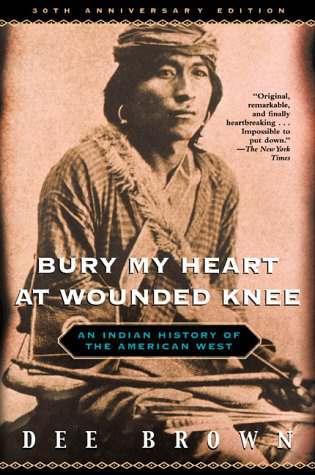 John: This game covers the wars with broad strokes. Plains Indian Wars is a very basic approach to a long and complicated conflict. It does not delve into the basic culture of the Plains Nations. I guess I did allow for Indian ambushes as their knowledge of the land and conception of warfare lent en emphasis on ambush. The best way I can answer your question is to emphasize buffalo, horses and intertribal rivalry. The buffalo, which sustained Native-Americans on the Plains, are only lightly touched on in the game. Likewise, the horses they relied on to follow and hunt buffalo and raid are not directly addressed. As for intertribal rivalry, this I turned on its head, allowing the Plains nations to unite early on so they stood a fighting chance to deter, if not halt, the tide of European settlers that flowed over them. My hope, as with all my designs is that the game will intrigue players enough to dig deeper into Plains Indian culture. It is a rich story filled with courage and sadness. To my way of thinking, there is no better place to start than Dee Brown’s Bury My Heart at Wounded Knee.
John: This game covers the wars with broad strokes. Plains Indian Wars is a very basic approach to a long and complicated conflict. It does not delve into the basic culture of the Plains Nations. I guess I did allow for Indian ambushes as their knowledge of the land and conception of warfare lent en emphasis on ambush. The best way I can answer your question is to emphasize buffalo, horses and intertribal rivalry. The buffalo, which sustained Native-Americans on the Plains, are only lightly touched on in the game. Likewise, the horses they relied on to follow and hunt buffalo and raid are not directly addressed. As for intertribal rivalry, this I turned on its head, allowing the Plains nations to unite early on so they stood a fighting chance to deter, if not halt, the tide of European settlers that flowed over them. My hope, as with all my designs is that the game will intrigue players enough to dig deeper into Plains Indian culture. It is a rich story filled with courage and sadness. To my way of thinking, there is no better place to start than Dee Brown’s Bury My Heart at Wounded Knee.
Grant: What tribes are depicted in the game and how do you bring out their unique attributes in the design?
John: The game divides the Great Plains north and south using the planned route of the transcontinental railway as the imaginary border. Plains Nations are therefore divided into Northern and Southern Tribes or Nations. The Northern Plains Tribes, or NPT, are represented by the Sioux, Assiniboine, Blackfeet, Mandan, and Hidatsa. The Southern Plains Tribes, or SPT, are represented by the Apache, Cheyenne, Comanche and Kiowa. These are by no means all of the Native-American nations involved in the wars but it does represent the primary nations. Regarding specific attributes – I want players to understand this is a basic approach. I do not pretend to emphasize cultural differences. I point out the contention held between the Southern Nations and the Mexicans as well as the contention held between the Crow and the Sioux as represented in the purple “Enemies” regions on the board. That said, I do encourage players to delve deeper into the background of Plain’s cultures. It is a rewarding undertaking.
Grant: What does the title Plains Indian Wars convey? How is this considered a wargame with no counters?
John: The title, Plains Indian Wars, is a catch-all phrase that includes a string of separate tribal conflicts with the U.S. cavalry and invading immigrant streams. These conflicts stretched from Red Cloud’s Fetterman Massacre in 1866 following the American Civil War through the disastrous Wounded Knee Massacre in 1890, a period of roughly two and a half decades. This is a card-driven, cube game. Bodies of men, whether settlers, cavalry, or war bands are represented by colored cubes. What does the game convey? I want players to recognize the vast region over which the Indians (I make no apologies for the use of the erroneous term, Indian, as it applies to Native-Americans. I do not employ it to be derogatory but rather to convey period speech) roamed and struggled to keep free of European settlers. It was an impossible task, made more-so by an endless string of broken treaties. I hoped, in this small simple way, to give players a better sense of how “winning the West” meant “losing the West” as well.
Grant: What is the goal of each player and how do they go about reaching this target?
John: In a two player game, the U.S. player’s goal is to complete the railroad and control as many of the Plains regions as possible. The Indian player’s goal is to prevent the building of the railroad and to retain as many of the Plains regions as possible, and in addition expand into the Northern and Southern “Enemies” regions.
Grant: Who designed the map and what area of the country does it focus on?
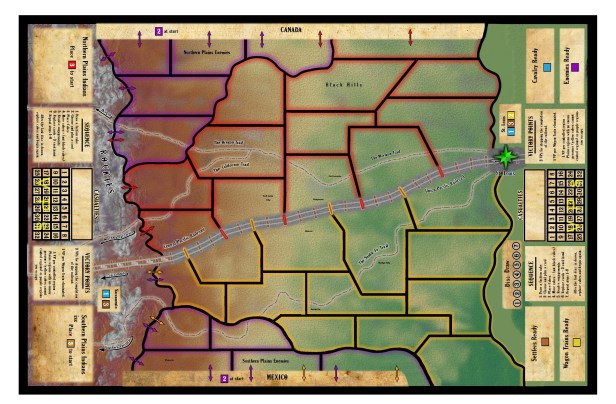
John: I noticed online that an interested party questioned the abstract approach to the map. I designed it that way because I wanted players to recognize from the start that PIW only gives a casual nod to the historical aspects of the conflict. There is no way the Indian Nations could have prevented the destruction of their Plains culture and the loss of their land, even if they had allied early on. This is nothing more than a great “what-if” scenario. The current iteration of the map was done by the talented artist, Bill Morgal. Framed by Canada to the North, the Rockies in the West, Mexico in the South, and the Mississippi in the East, the regional borders are significant in no way, shape or form.
Grant: I thought I noticed Bill’s style in the map. Why is the rail so prominent in the middle of the map?
John: The prominence of the planned railroad route is significant. It provides a demarcation between the Northern and Southern Nations. It provides a bonus to players who complete its construction or prevent its construction and it provides players with the knowledge that its completion essentially doomed the Plains Indian culture.
Grant: What is the purpose of the ready boxes?
John: Ready boxes hold the maximum number of cubes available for placement, but placement is restricted by card play. If no cubes are available in the ready box there are then no reinforcements available for placement. Note that the cube limits are significant. The number of NPT and SPT cubes is relatively equal but declines in number as the game progresses to show historical population decline. There are significantly fewer cavalry cubes to show the logistical and philosophical difficulty of assigning the military to Plains duty. There are significantly more, seemingly endless, settler cubes to reflect the boundless immigrant drive to own land, and the mindset that it was free for the taking.

Grant: What is the Sequence of play?
John: The current Sequence of Play is as follows:
1) Draw and place a random faction disc;
2) Chosen Faction Chooses and plays a card or cards;
3) Place or remove cubes (per card instructions);
- When the purple disc is drawn, the Cavalry Player places one Purple cube in a purple region.
- When the Yellow disc is drawn the Settler player places 2 yellow cubes in St. Louis.
4) Move up to the number of faction groups up to the number of regions indicated on the card.
- Black cubes never move.
- Purple cube movement is based on the last Cavalry card (if the last Cavalry card was a text card, 2 purple groups or groups that contain purple cubes move 2 regions.)
- Yellow cubes all move ahead one region including those in St. Louis.
5) Resolve all engagements;
6) Replace as many cards as played;
7) Repeat steps 1-6 for remaining factions.
Grant: One thing that I found really interesting in my reading was the issue of turn order. How is turn order determined and why did you choose this method?
John: Turn order in PIW is determined by a faction disc draw. There are six discs to be drawn representing: the NPT, the SPT, the Cavalry, the Settlers, the Wagon Trains and the Railroad. From the start, I wanted random turn order to reflect competing goals and the unpredictability of railroad construction and wagon train movement. There is little predictability of when and where a particular faction will act.
Grant: How are victory points scored? How can either side cause an auto win?
John: Essentially, VPs are scored at the end of the game, although players do earn ongoing points for wagon trains. The U.S. player earns one VP for each wagon train cube that exits into the Rockies. The Indian player earns one VP for each wagon train cube that is captured. At the end of the game, players earn one point for each region they control (Wagon trains do not control regions as they are considered moving). Indians are also awarded points for expanding into “Enemies” regions, the U.S. player is not. Any empty Plains region is considered Indian controlled. In addition, the U.S. player is awarded 3 VPs for completing the transcontinental railroad (linking Eastern and Western railroads) – this by the way, will end the game. The Indian player is awarded 3 VPS for preventing this from happening when any one faction runs out of cards.
Grant: What general strategies should each side adopt?
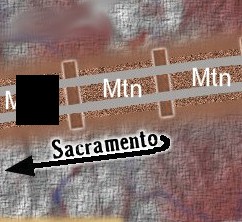 John: The Indian player should make progress into the “Enemies” Regions early on when the U.S. is still too weak to drain forces away from such operations. Preventing the concentration of settler cubes at railheads will slow construction of the railroad and ultimately earn bonus points. In addition, the Indian player should mix forces early and often. And unaccompanied wagon trains should never be ignored, but when attacking them, make sure it is with a mixed force as they are difficult to capture and tend to slip away – a failed attack on a wagon train enables it to move that much closer to reaching the Rockies. Mixed forces allow additional dice in battle and the only way the Indian is able to match the growing power of U.S. forces. Conversely, the U.S. player should not be too eager to grab land early on as it will spread him thin and expose his forces to massive losses. He should instead focus on steady construction of the railroad, ferrying wagon trains as far as he is able and pouncing on isolated war bands. In a straight up fight, the U.S. will usually win and in the end game this is a good strategy, but early on it is a losing strategy.
John: The Indian player should make progress into the “Enemies” Regions early on when the U.S. is still too weak to drain forces away from such operations. Preventing the concentration of settler cubes at railheads will slow construction of the railroad and ultimately earn bonus points. In addition, the Indian player should mix forces early and often. And unaccompanied wagon trains should never be ignored, but when attacking them, make sure it is with a mixed force as they are difficult to capture and tend to slip away – a failed attack on a wagon train enables it to move that much closer to reaching the Rockies. Mixed forces allow additional dice in battle and the only way the Indian is able to match the growing power of U.S. forces. Conversely, the U.S. player should not be too eager to grab land early on as it will spread him thin and expose his forces to massive losses. He should instead focus on steady construction of the railroad, ferrying wagon trains as far as he is able and pouncing on isolated war bands. In a straight up fight, the U.S. will usually win and in the end game this is a good strategy, but early on it is a losing strategy.
Grant: What type of cards are in the game and how are they used? Is this a card driven game?
John: Each faction (NPT, SPT, Settler & Cavalry) has a 13 card deck. Each has 10 reinforcement/movement cards and three event cards. The cards correspond to historical individuals or situations that were present or occurred during the Plains Indian Wars. For example, included are: Cochise, Quanah Parker, Red Cloud, Wovoka, Crook, Sherman, Fort Laramie, Fort Lincoln, James Beckworth and Black Hills Gold. A few cards are reactive and one is an immediate play. The immediate play is the Custer card. This is my nod to the hubris of General George Armstrong Custer – whom, if he had survived, might well have been President after Grant.
Grant: How are cubes used in the design?
John: As previously explained, cubes represent units of force. The color of the cube determines to what faction each belongs. How are the cubes placed? Most cards allow 2-5 cubes to be taken from the ready box and placed in a faction’s territory or in the case of the U.S. player in St. Louis or Sacramento. How do the cubes move? The same cards that allow for reinforcement allow for regional movement. Cards indicate how many groups (1-3) may move how many regions (1-3). A group describes all the cubes within one region.
Grant: How does combat work?
John: When a force moves into a region occupied by an opposing force, combat takes place. Players identify how many cubes are present from each faction to determine how many dice may be rolled. Example: A U.S. force of 1 Cavalry cube and 3 Settler cubes may roll three dice. One Cavalry die for the one Cavalry cube and two Settler dice for the three Settler cubes (no single faction is allowed more than two dice per battle). So, if this force faced a maximum stacking of 8 Indian cubes, 3 NPT and 5 SPT, the Indian player would be rolling 4 dice – 2 per faction.
Grant: Can you describe the faction dice? What symbols are on the dice?
John: Each faction die offers three different effects in battle. A weapon (Spear, bow & arrow, pistol, knife, crossed sabers) indicates a hit. A hit means one opposing cube is removed. A Treaty symbol indicates the possibility of calling off combat. Any time both sides (U.S. and Indian) roll one or more Treaty symbols, the battle is called off and the side with the greater force relocates the lesser force. While a blank side indicates the opportunity for one cube to withdraw from battle.
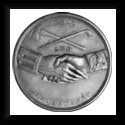


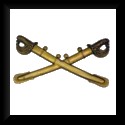
Grant: Each sides forces have differing firepower strengths. How does this balance out in the design?
John: The settler faction has an ocean of cubes but they are relatively weak, having only a single weapon on each of their die (hit probability of 17%). The NPT, SPT and Enemies dice each have two weapons per die (hit probability of 33%). The Cavalry, having better weapons, has three weapons per die (hit probability of 50%). So you can see the necessity of the Cavalry accompanying settler cubes and wagon cubes to protect them. At the same time, Cavalry against a single Indian faction has a distinct advantage but against a mixed force it is at a disadvantage unless it has settlers along to soak up the damage (tongue in cheek – this is counter-productive to their mission but it is what the military might call “acceptable losses”).
Grant: In reading the promotional material provided on GMT’s game page, I saw the following statement: “Unfortunately, the journalistic adage, ‘If it bleeds, it leads,’ is true of our American history. Sensational Conflict, victory and progress are what kids grow up learning, but there is always so much more behind and leading up to the infamous incidents we emphasize.” What did you mean by this statement?
John: Beyond a doubt, my drive to publish this game was to highlight how unfair yet how inevitable the Plains Indian Wars were. Our cultural emphasis on teaching about the victories while neglecting the motives behind those victories or the tragic results of those victories leads to a misunderstanding of our history and how other nations view and mistrust us as a nation.
Grant: How did this belief drive your design?
John: Glad you asked. It was foremost in my mind not only in this design but in all my designs. I might sound preachy but I want players to reflect not so much on the glory of battle, not so much on the winning, but on the holistic effects of war on cultures and the damaging effects that remain generations after peace is achieved. For example, I was involved in the Vietnam War, although only in a minor role – yet to this day, I view the country with an abiding mistrust. My father, also a Marine veteran, viewed Japan in much the same way after WWII. To this day there resides bitterness in the hearts of certain Filipinos, Haitians, Mexicans … the list goes on, and certainly Native Americans because of the actions our country has taken. Were we any less rapacious than any other country? Hardly, but understanding the whole of history is so much more fulfilling than understanding just a part of it.
“I might sound preachy but I want players to reflect not so much on the glory of battle, not so much on the winning, but on the holistic effects of war on cultures and the damaging effects that remain generations after peace is achieved. For example, I was involved in the Vietnam War, although only in a minor role – yet to this day, I view the country with an abiding mistrust.”
Grant: What makes the game fast playing? What has been the reaction of players?
John: It is an uncomplicated game that can be taught in 10-15 minutes. A complete novice can play a game in less than 90 minutes. I think the faction disc draw has a lot to do with rapid play, as players eagerly anticipate the next step and two of the disc draws are all but perfunctory. The Railroad either extends or it doesn’t based on the location of settler/workers and the wagon cubes just keep moving forward – no thinking to that element of the game. The reaction of players has been universally enthusiastic. Unlike my other designs where there have been those who argued about certain mechanics or my depiction of the theme, every person who has sat down and played Plains Indian Wars has come away delighted. That I was able to impress Rick Young who has a critical eye and hard to impress meant everything to me.
Grant: What needs to be improved or tightened through further play testing?
John: I don’t think additional tightening is necessary. It has been tightened through constant test-play over the past four years. It works. Why tinker with mechanics that have already reached the sweet spot.
Grant: What is your anticipated timeline for the game?
John: It is a P500 entry so that depends not on me but on its general acceptance. I would hope that its subject, its colorful components, its ease and rapidity of play will all encourage its acceptance. I can foresee its production in 2018 – then again, that is not up to me or GMT. It is up to people like you and fans of the game. I hope in time, there will be many who have a kind word to say about it!

Thanks John for another great interview and for another very thoughtful design on the Indian Nations. I find this topic fascinating and have grown to love playing games on the subject as my recent experience with another GMT title, Comanchería: The Rise and Fall of the Comanche Nation, has me very interested in other similar games. I have already added this game to my growing P500 list and urge others to do the same.
If you are interested in ordering a copy of Plains Indian Wars, you can follow this link to the game page on the GMT Games website where it is listed for the P500 price of $43.00: https://www.gmtgames.com/p-654-plains-indian-wars.aspx
-Grant





Thank you, Grant, for your thoughtful questions.
LikeLike
As always it was my pleasure John. Thanks for all the great games you have worked on over the last year. I look forward to playing PIW next year.
LikeLike